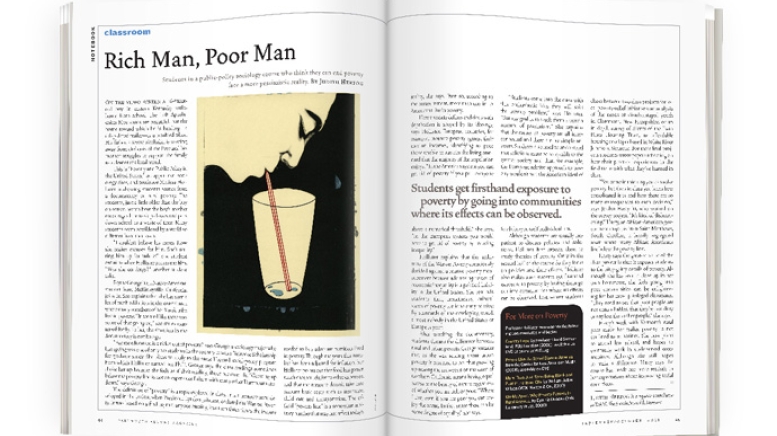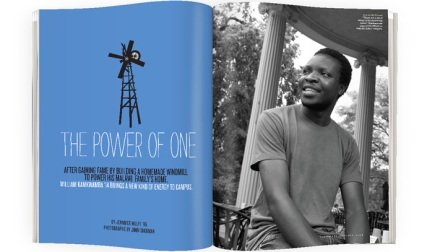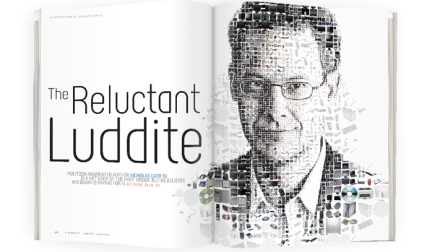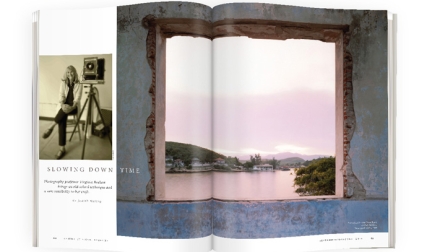On the video screen a 16-year-old boy in eastern Kentucky walks home from school. The lush Appalachian Mountains are beautiful, but the home toward which he is heading—a dilapidated trailer—is a troubled place. His father, a severe alcoholic, is wasting away from cirrhosis of the liver and his mother struggles to support the family as a cleaner at a local motel.
This is “Poverty and Public Policy in the United States,” an upper-level sociology class, and professor Matissa Hollister is showing students scenes from a documentary on rural poverty. The students, just a little older than the boy on screen, watch how the boy’s mother encourages him to skip classes and puts down school as a waste of time. Many students seem bewildered by a world so different from their own.
“I couldn’t believe his mom. How she makes excuses for him. She’s setting him up for failure!” one student exclaims when Hollister pauses the film. “Was she on drugs?” another student asks.
Blythe George ’12, a Native-American student from McKinleyville, California, joins in. She explains that she has seen a lot of meth addiction in the coastal area where many members of her Yurok tribe live in poverty. “It seemed like there was some of that going on,” she states matter-of-factly. To her, the situation in the documentary is not foreign.
“For me education is a ticket out of poverty,” says George, a sociology major who last spring was one of only 20 students in the country to win a Beinecke Scholarship for graduate study. She plans to apply to the same Harvard social-policy program from which Hollister earned her Ph.D. George says the class readings sometimes choke her up because she feels as if she’s reading about her own life. “Growing up below the poverty line is not an experience I share with many other Dartmouth students,” says George.
The definition of “poverty” is a topic explored in class. It is a measurement developed in the 1960s, when President Lyndon Johnson declared the War on Poverty. It was based on a finding that anyone earning less than three times the income needed to buy adequate nutrition lived in poverty. Through the years this number has been adjusted for inflation, but Hollister points out that food has gotten much cheaper relative to other expenses, and that the measure doesn’t take into account basic costs such as insurance, child care and transportation. The official “poverty line” is a somewhat arbitrary number that may not reflect today’s reality, she says. Even so, according to the measurement, more than one in 10 Americans live in poverty.
How a society defines and deals with deprivation is shaped by its ideology, says Hollister. European countries, for example, measure poverty against their median incomes, identifying as poor those unable to sustain the living standard that the majority of the population enjoys. “In the American system you can get rid of poverty if you pull everyone above a numerical threshold,” she says. “In the European system you would have to get rid of poverty by reducing inequality.”
Hollister explains that the architects of the War on Poverty consciously decided against a relative poverty measurement because addressing issues of economic inequality is a political liability in the United States. She reminds students that, nonetheless, cultural views of poverty are inherently relative: By standards of the developing world, almost nobody in the United States or Europe is poor.
After watching the documentary, students discuss the difference between rural and urban poverty. George remarks that as she was reading about urban poverty it occurred to her that growing up among the redwoods on the coast of northern California means having equal access to the beauty of nature regardless of whether you are rich or poor. “Where I live, even if you are poor you can enjoy the ocean. In that sense there can be some degree of equality,” she says.
“Students come into the class with this enthusiastic idea they will solve the poverty problem,” says Hollister. “But my goal is to teach them a certain amount of pessimism.” She explains that the causes of poverty are all interconnected and there are no simple answers. Students also need to understand that solutions must be acceptable to the greater society and that, for example, the European relative approach to poverty wouldn’t suit the American ideal of fend-for-yourself individualism.
Although students are usually impatient to discuss policies and solutions, Hollister first expects them to study theories of poverty. Only in the second half of the course do they focus on policies and their effects. Hollister also makes sure students get firsthand exposure to poverty by having them go out into communities where its effects can be observed. Last winter students chose between two class projects for local poverty-relief initiatives: an analysis of the needs of disadvantaged youth in Claremont, New Hampshire, or an in-depth survey of clients of the Twin Pines Housing Trust, an affordable housing developer based in White River Junction, Vermont. For their final projects students wrote papers reflecting on how their practical experiences in the field tie in with what they’ve learned in class.
“You come in thinking you can solve poverty, but then in class you learn how complicated it is and how there are so many consequences to each decision,” says Jordan Hasty ’11, who worked on the survey project. “It’s kind of disheartening.” Hasty, an African-American government major, is from Saint Matthews, South Carolina, a heavily segregated town where many African Americans live below the poverty line.
Hasty says the greatest value of the class project is that it exposes students to the nitty-gritty details of poverty. Although she has seen it close-up in her own hometown, she feels going into poor communities can be enlightening for her more privileged classmates. “They need to see that poor people are not untouchables, that they’re not dirty or any less than other people,” she says.
Hasty’s work with Vermont’s rural poor made her realize poverty is not confined to minorities. She now plans to attend law school, and hopes to eventually work in underserved com-
munities. Although she still hopes to make a difference, Hasty says the course has made her more realistic in her expectations about improving social
conditions.
Judith Hertog is a regular contributor to DAM. She lives in Norwich, Vermont.
For more information on the topic of poverty, professor Hollister recommends the following documentaries and books:
Country Boys, by producer David Sutherland, PBS Frontline (2006); available on DVD or online at PBS.org
People Like Us: Social Class in America, from the Center for New American Media (2006); available on DVD
More Than Just Race: Being Black and Poor in the Inner City, by William Julius Wilson (W.W. Norton & Co., 2009)
Worlds Apart: Why Poverty Persists in Rural America, by Cynthia Duncan (Yale University Press, 2000)




